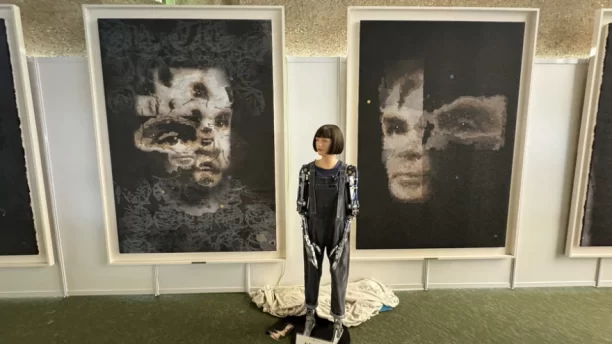Not long ago, the New York Times, the Guardian and other newspapers and media worldwide were passionately commenting on something unprecedented: the entry of a painting made with an AI program into MOMA, New York’s Museum of Modern Art. The painting belonged to Refik Anadol, an artist who used artificial intelligence and thousands of other original paintings at the museum’s disposal to create a work commemorating the institution’s 200 years. The AI painting was exhibited there and became the trigger for a long debate about the future of art in the age of the prevalence of new technological achievements and tools.
There were dozens of comments and reactions that varied from that this is the beginning of the end, to that in the near future humans – and especially artists – will be completely replaced by robots. So looking at the latest creative achievement of artificial intelligence, namely the painting “AI God. Portrait of Alan Turing”, certainly one comes closer to verifying the above concerns, since this time it is not only the work made of code, but also the artist himself.
Advertising
It is about the robot Ai-Da, which created a portrait of the famous British mathematician and scientist Alan Turing – who is considered one of the fathers of artificial intelligence. “And where’s the weirdness in that?”, one might think, especially now that we live in an age with dozens of AI programs creating art, music and images. In this particular case, not only is the AI-painter a humanoid machine with a short, checkered haircut and fashionable dungarees, but his work, like another authentic Basquiat or Hockney, was auctioned by Sotheby’s for $1.1 million. This event marks a major shift in the intersection of technology, creativity and the traditional art scene, challenging conventional ideas of what art can be and who – or what – can ultimately create it.

Robotic Renaissance
Ai-Da is more than just a machine—she’s a highly sophisticated artist with artificial intelligence, equipped with advanced robotics and algorithms that allow her to mimic human-like creativity. The brainchild of Aidan Meller, a former gallerist living outside Oxford, England, Ai-Da, named after Ada Lovelace, the 19th-century mathematician often credited as the first computer programmer, combines mechanical learning, computer vision and robotic arm technology to create her works of art.
Her creative process begins with her cameras scanning a subject or scene. The visual data collected is processed through algorithms that analyze shapes, colors and compositions, producing a digital interpretation of the image. Ai-Da’s programming involves deep learning models trained on thousands of artworks, allowing it to mimic various styles. Once that data is processed, her robotic arm moves across a canvas to render the work, applying strokes with a precision reminiscent of human artistry.
Advertising
What makes Ai-Da stand out, however, is her ability to innovate beyond planned guidelines. The algorithms built into her system don’t just reproduce existing styles—they’re designed to produce unique, original works that carry an air of spontaneity and abstract interpretation, blurring the lines between mere copying and genuine creativity.
AI of a million
The sale of Ai-Da’s painting for $1.1 million is not just a milestone for AI technology, but a turning point for the art industry. This honor signals that collectors and the wider art world recognize the value of a medium that questions the essence of art itself. Historically, art has been viewed as a uniquely human endeavor, incorporating emotion, personal experience, and purpose. The emergence of artificial intelligence-driven art forces a reassessment of these concepts.
Critics argue that AI lacks true creativity or emotional depth, viewing its work as the product of complex programming rather than genuine artistic insight. However, proponents argue that TN can reflect contemporary issues such as our relationship with technology, making it a new important voice in contemporary art. Ai-Da’s works, with their particular combination of logic and unpredictability, introduce philosophical questions such as: “Can machines have artistic intent?” or “What is the role of human creators in working with artificial intelligence?”
The Future of Art: Collaboration or Competition?
The $1.1 million sale highlights a potential shift toward collaboration between humans and machines in the creative fields. While some fear that AI may replace human artists, others see it as a tool to expand the boundaries of human creativity. Artists could incorporate the potential of AI to develop new techniques and perspectives, using it as a partner rather than a competitor.
Art schools and workshops are already beginning to incorporate artificial intelligence tools to teach new generations of artists the symbiosis between technology and creativity. So the question may not be whether artificial intelligence will replace human artists, but how they can work together to expand the boundaries of what is possible in art. It seems that what Ai-Da has accomplished is to invite us all to reconsider what it means to be an artist and how art reflects the ever-changing landscape of human ingenuity and technological superiority.
With information from www.protothema.gr
Source: enallaktikidrasi.com


